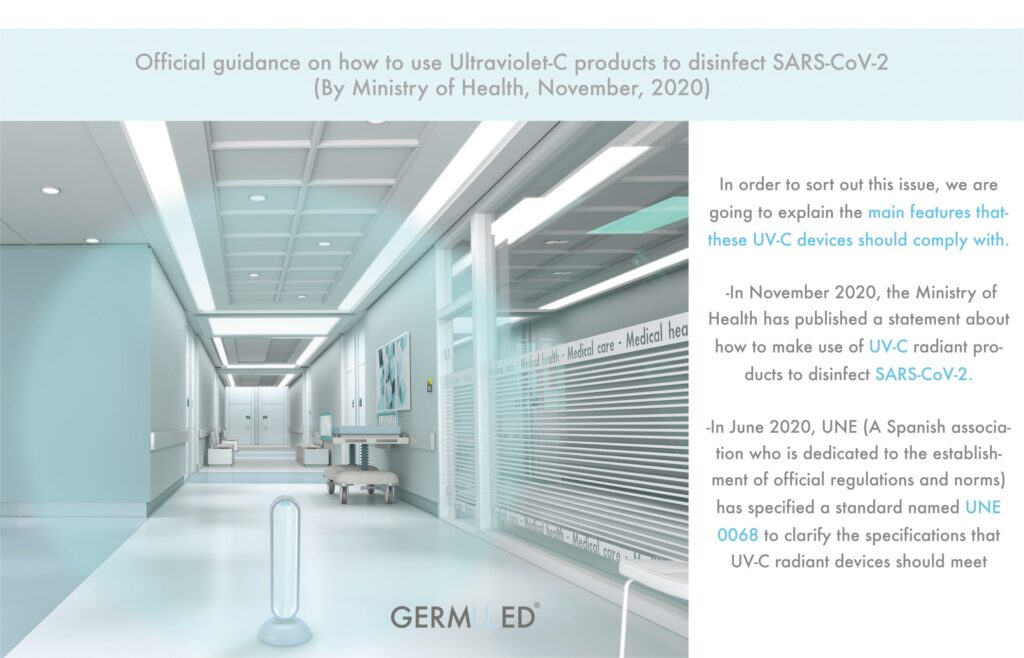Imagine that a person, who has no knowledge of UV-C radiation, is thinking about acquiring an equipment to disinfect SARS-CoV-2. He may find it difficult, won’t he?
In order to sort out this issue, we are going to explain the main features that these UV-C devices should comply with.
However, what’s the ground for this explanation?
-In November 2020, the Ministry of Health has published a statement about how to make use of UV-C radiant products to disinfect SARS-CoV-2.
-In June 2020, UNE (A Spanish association who is dedicated to the establishment of official regulations and norms) has specified a standard named UNE 0068 to clarify the specifications that UV-C radiant devices should meet.
The person may ask: Is really efficient to use UV-C radiation to disinfect the air and surfaces during SARS-CoV-2 pandemic?
So far, the Ministry of Health has made it clear that UV-C radiant devices could inactivate SARS-CoV-2 in an easy and efficient way.
They also have pointed out that there is NOT ANY evidence that could demonstrate the relevance of ozone in improving the efficacy and the safety of disinfection.
Our answer to the aforementioned question is YES. UV-C radiation proves to be an easy and efficient way to disinfect the air and surfaces. OZONE-FREE for sure.
The second question that this person might ask is: Is UV-C safe in disinfecting the air and surfaces?
According to the Standard of UNE0068, UV-C radiant devices should meet the following requirements.
-General requirements: Obtaining a Technical documentation and EU declaration of conformity that includes directives below:
- Directive 2014/35/UE: Relating to the electrical material
- Directive 2014/30/UE: Relating to the electromagnetic compatibility
- Directive 2011/65/UE: Relating to the hazardous substances’ restrictions
- Directive 2012/19/UE: Relating to the electrical and electronic waste restrictions (RAEE)
- Directive 2006/25/CE: Minimum health and safety requirements regarding the exposure of the workers to artificial optical radiation
-Additionally, apparatus that incorporates a series of UV-C radiation emitting sources shall be in accordance with the safety objectives.
General conditions:
- Make sure the electrical equipment will be used safely
- The electrical equipment, together with its component parts, shall be made in such a way as to ensure that it can be safely and properly assembled and connected
- The electrical equipment and its components shall be designed and manufactured to ensure a protection against hazards which may be caused by electrical martial or external influence
Protection against hazards arising from the electrical equipment:
- Persons, domestic animals and property are not endangered
- Temperatures, arcs or radiation which would cause a danger, are not produced;
- Persons, domestic animals and property are adequately protected against non-electrical dangers caused by electrical equipment
- The insulation is suitable for the foreseeable conditions
Protection against hazards which may be caused by external influences:
- Meets the expected mechanical requirements in such a way that persons, domestic animals and property are not endangered
- Is resistant to non-mechanical influences in expected environmental conditions, in such a way that persons, domestic animals and property are not endangered;
- Does not endanger persons, domestic animals and property in foreseeable conditions of overload.
Among all the apparatuses that emit direct radiation, only those emit in wavelengths between 200nm to 280nm are marked as UV-C label.
These apparatuses should also comply with these requirements:
- Be equipped with a timer to facilitate the connection and disconnection, which allows people to preset the working time and avoid unnecessary human manipulation of the switch on/off.
- Having a presence detector integrated in it. When human presence is detected in the irradiation area, the equipment disconnects automatically.
About whether UV-C products are safe in disinfecting the air and surfaces, after analyzing all the information above, the answer is: It depends on the manufacturer. Actually, the majority of products that exist on the market don’t meet these regulations (For example: Some produce ozone, some don’t carry a presence detector, some don’t possess CE certification, some don’t have a WEEE-waste from electrical and electronic equipment number, etc.)
We are proud to say that our Germiled could meet all the requirements we have mentioned earlier. If you are thinking about buying a germicidal product from this brand, the answer to both previous questions are YES. You are welcomed to ask for all accreditation documents and certificates via our email: office@germiled.com or you can check it on our website: https://www.germicidalamp.com/en/.

